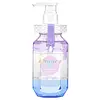What's inside
What's inside
 Key Ingredients
Key Ingredients

No key ingredients
 Benefits
Benefits

 Concerns
Concerns

No concerns
 Ingredients Side-by-side
Ingredients Side-by-side

Water
Skin ConditioningLauramidopropyl Betaine
CleansingSodium Lauroyl Methylalanine
Sodium C14-16 Olefin Sulfonate
CleansingCocamidopropyl Betaine
CleansingCocamide Methyl Mea
Potassium Cocoyl Hydrolyzed Keratin
Skin ConditioningHoney
HumectantHoney Extract
HumectantHydrolyzed Honey Protein
Skin ConditioningGluconobacter/Honey Ferment Filtrate
Skin ConditioningPropolis Extract
Skin ConditioningRoyal Jelly Extract
Skin ConditioningHydrolyzed Royal Jelly Extract
Skin ConditioningArgania Spinosa Kernel Oil
EmollientLevulinic Acid
PerfumingKeratin
Skin ConditioningConvallaria Majalis Extract
Skin ConditioningSilk
Hyaluronic Acid/Polyglutamic Acid Crosspolymer
AntioxidantC9-11 Alkyl Glucoside
CleansingPlatinum
AntimicrobialMyristyl Betaine
CleansingTea-Cocoyl Glutamate
CleansingPolyquaternium-10
Polyquaternium-47
Skin ConditioningDisodium EDTA
Sodium Chloride
MaskingPotassium Hydroxide
BufferingCitric Acid
BufferingPentasodium Pentetate
Glycerin
HumectantSilver Oxide
AntimicrobialSodium Phosphate
BufferingDisodium Phosphate
BufferingSodium Bicarbonate
AbrasivePhytic Acid
PPG-7
Skin ConditioningSodium Benzoate
MaskingPentylene Glycol
Skin ConditioningHydroxyacetophenone
AntioxidantButylene Glycol
HumectantDipropylene Glycol
HumectantPhenoxyethanol
PreservativeParfum
MaskingWater, Lauramidopropyl Betaine, Sodium Lauroyl Methylalanine, Sodium C14-16 Olefin Sulfonate, Cocamidopropyl Betaine, Cocamide Methyl Mea, Potassium Cocoyl Hydrolyzed Keratin, Honey, Honey Extract, Hydrolyzed Honey Protein, Gluconobacter/Honey Ferment Filtrate, Propolis Extract, Royal Jelly Extract, Hydrolyzed Royal Jelly Extract, Argania Spinosa Kernel Oil, Levulinic Acid, Keratin, Convallaria Majalis Extract, Silk, Hyaluronic Acid/Polyglutamic Acid Crosspolymer, C9-11 Alkyl Glucoside, Platinum, Myristyl Betaine, Tea-Cocoyl Glutamate, Polyquaternium-10, Polyquaternium-47, Disodium EDTA, Sodium Chloride, Potassium Hydroxide, Citric Acid, Pentasodium Pentetate, Glycerin, Silver Oxide, Sodium Phosphate, Disodium Phosphate, Sodium Bicarbonate, Phytic Acid, PPG-7, Sodium Benzoate, Pentylene Glycol, Hydroxyacetophenone, Butylene Glycol, Dipropylene Glycol, Phenoxyethanol, Parfum
Ingredients Explained
These ingredients are found in both products.
Ingredients higher up in an ingredient list are typically present in a larger amount.
Citric Acid is an alpha hydroxy acid (AHA) naturally found in citrus fruits like oranges, lemons, and limes.
Like other AHAs, citric acid can exfoliate skin by breaking down the bonds that hold dead skin cells together. This helps reveal smoother and brighter skin underneath.
However, this exfoliating effect only happens at high concentrations (20%) which can be hard to find in cosmetic products.
Due to this, citric acid is usually included in small amounts as a pH adjuster. This helps keep products slightly more acidic and compatible with skin's natural pH.
In skincare formulas, citric acid can:
While it can provide some skin benefits, research shows lactic acid and glycolic acid are generally more effective and less irritating exfoliants.
Most citric acid used in skincare today is made by fermenting sugars (usually from molasses). This synthetic version is identical to the natural citrus form but easier to stabilize and use in formulations.
Read more about some other popular AHA's here:
Learn more about Citric AcidGlycerin is already naturally found in your skin. It helps moisturize and protect your skin.
A study from 2016 found glycerin to be more effective as a humectant than AHAs and hyaluronic acid.
As a humectant, it helps the skin stay hydrated by pulling moisture to your skin. The low molecular weight of glycerin allows it to pull moisture into the deeper layers of your skin.
Hydrated skin improves your skin barrier; Your skin barrier helps protect against irritants and bacteria.
Glycerin has also been found to have antimicrobial and antiviral properties. Due to these properties, glycerin is often used in wound and burn treatments.
In cosmetics, glycerin is usually derived from plants such as soybean or palm. However, it can also be sourced from animals, such as tallow or animal fat.
This ingredient is organic, colorless, odorless, and non-toxic.
Glycerin is the name for this ingredient in American English. British English uses Glycerol/Glycerine.
Learn more about GlycerinPentylene glycol is typically used within a product to thicken it. It also adds a smooth, soft, and moisturizing feel to the product. It is naturally found in plants such as sugar beets.
The hydrophilic trait of Pentylene Glycol makes it a humectant. As a humectant, Pentylene Glycol helps draw moisture from the air to your skin. This can help keep your skin hydrated.
This property also makes Pentylene Glycol a great texture enhancer. It can also help thicken or stabilize a product.
Pentylene Glycol also acts as a mild preservative and helps to keep a product microbe-free.
Some people may experience mild eye and skin irritation from Pentylene Glycol. We always recommend speaking with a professional about using this ingredient in your routine.
Pentylene Glycol has a low molecular weight and is part of the 1,2-glycol family.
Learn more about Pentylene GlycolWater. It's the most common cosmetic ingredient of all. You'll usually see it at the top of ingredient lists, meaning that it makes up the largest part of the product.
So why is it so popular? Water most often acts as a solvent - this means that it helps dissolve other ingredients into the formulation.
You'll also recognize water as that liquid we all need to stay alive. If you see this, drink a glass of water. Stay hydrated!
Learn more about Water